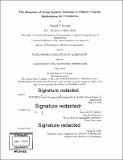The response of ocean salinity patterns to climate change : implications for circulation
Author(s)
Levang, Samuel J.(Samuel James)
Download1119388656-MIT.pdf (18.88Mb)
Other Contributors
Joint Program in Oceanography/Applied Ocean Science and Engineering.
Massachusetts Institute of Technology. Department of Earth, Atmospheric, and Planetary Sciences.
Woods Hole Oceanographic Institution.
Advisor
Raymond W. Schmitt.
Terms of use
Metadata
Show full item recordAbstract
Global patterns of ocean salinity arise from the exchange of freshwater between the sea surface and the atmosphere. For a quasi-steady state system, these surface fluxes are balanced by compensating transports of salt in the ocean interior. In a warming climate, the atmosphere holds additional water vapor which acts to intensify the global water cycle. Amplified freshwater fluxes are then absorbed at the surface and propagate along ocean circulation pathways. Here, we use coupled model results from the CMIP5 experiment to identify coherent responses in the atmospheric water cycle and in ocean salinity patterns. Some aspects of the response are consistent across models, while other regions show large inter-model spread. In particular, the salinity response in the North Atlantic subpolar gyre, where the mean salinity plays a role in maintaining high surface density for deep-water formation, has low confidence in CMIP5 models. To understand how differences in ocean circulation may affect this response, we use two techniques to diagnose the role of salt transports in the present-day climate. The first is a salt budget within the surface mixed layer, which identifies major transport processes. The second is a Lagrangian particle tracking tool, used to understand the regional connectivity of water masses. From this analysis, we find that anomalous freshwater signals become well mixed within the ocean gyres, but can be isolated on larger scales. The subpolar Atlantic salinity response generally shows freshening at the surface, but is sensitive to the transport of anomalously salty water from the subtropics, a largely eddy-driven process. As CMIP5 models use a range of eddy parameterizations, this is likely a source of uncertainty in the salinity response. Finally, we investigate the effect of salinity changes on the deep overturning cells and other circulations, and find a complex influence that also depends on the details of advective pathways. In a warming scenario, water cycle amplification actually works to strengthen the Atlantic meridional overturning circulation due to the influence of enhanced subtropical evaporation.
Description
Thesis: Ph. D. in Physical Oceanography, Joint Program in Oceanography/Applied Ocean Science and Engineering (Massachusetts Institute of Technology, Department of Earth, Atmospheric, and Planetary Sciences; and the Woods Hole Oceanographic Institution), 2019 Cataloged from PDF version of thesis. Includes bibliographical references (pages 121-133).
Date issued
2019Department
Joint Program in Oceanography/Applied Ocean Science and Engineering; Massachusetts Institute of Technology. Department of Earth, Atmospheric, and Planetary Sciences; Woods Hole Oceanographic InstitutionPublisher
Massachusetts Institute of Technology
Keywords
Joint Program in Oceanography/Applied Ocean Science and Engineering., Earth, Atmospheric, and Planetary Sciences., Woods Hole Oceanographic Institution.